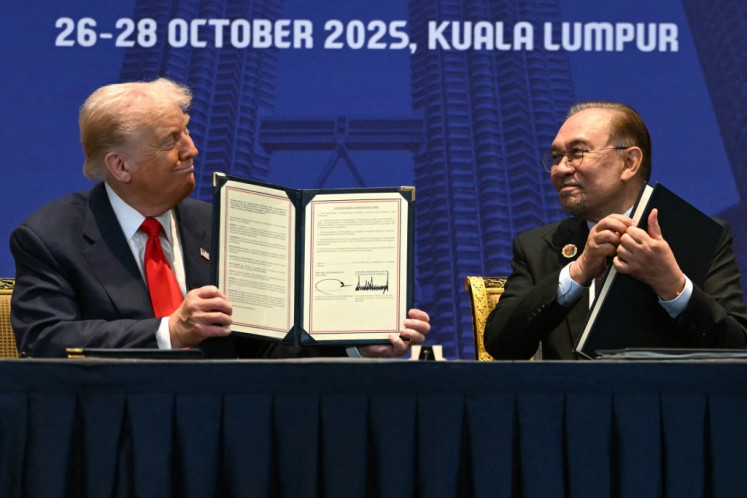Popular Reads
Top Results
Can't find what you're looking for?
View all search resultsPopular Reads
Top Results
Can't find what you're looking for?
View all search resultsCombating high cost of fintech for inclusion financial
However, in the middle of the fintech industry based on peer-to-peer lending, there are several fintechs that have a more inclusive business vision to help people with certain group segmentation, for example, Tani Hub, I-Grow, E-Fishery.
Change text size
Gift Premium Articles
to Anyone
F
intech peer to peer lending (P2P) services are able to penetrate the administrative difficulties experienced by banks in providing micro or ultra-micro credit to the public and MSMEs. Affordability of access is often not accompanied by education to customers, resulting in many implementation problems. In addition, the interest and fines are still very high, making financial inclusion an illusion.
For this reason, a breakthrough in risk management is needed through adequate information support by the Financial Service Authority (OJK). Meanwhile, the government can also provide stimulation to address the need for financial inclusion by modernizing cooperatives through the use of digital technology.
The OJK said in October that cumulatively there were 106 registered fintechs which had thus far distributed funds of up to Rp 260 trillion (US$18.5 billion) to 508 million accounts. From January-October 2021, there were 82.6 million lender accounts and 128 billion loaned funds. Meanwhile, from the borrower's side, there were 271 million accounts with total loans reaching 129 billion.
Most Fintech customers use these services consumptively. They often also neglect the contract so that they are entangled in accumulating interest and aggressively imposed fines. This is in line with massive offers and advertisements for the urban consumer segment, through pay later or credit for consumptive needs. Although the interest and fines mechanism has been regulated in OJK regulation 77/POJK/2016, the limits provided are very high, far exceeding the conventional banking average, especially when compared to subsidized MSME credit schemes such as the microcredit program (KUR).
OJK states that licensed fintech providers are allowed to charge 0.8 interest per day or 24 percent per month and fine limit up to 100 percent, which means that fintech is cumulatively allowed to provide interest equivalent to 288 percent per year. Whereas the average conventional bank loan is in the range of 12-14 percent per year. Meanwhile, KUR loans are only about 5-6 percent per year. The very high interest rate certainly does not allow business actors to utilize fintech for business or working capital financing.
At least the ideal business capital requirement should be below the potential net profit it generates. Thus, fintech is actually more targeting the urban middle class for short-term consumptive needs, compared to groups of micro-enterprises who need cheap and flexible funds. Ease of access that is not accompanied by rational costs is certainly only an illusion in developing financial inclusion.
However, in the middle of the fintech industry based on peer-to-peer lending, there are several fintechs that have a more inclusive business vision to help people with certain group segmentation, for example, Tani Hub, I-Grow, E-Fishery, which are engaged in financing agricultural and fisheries investment based on peer to peer lending to finance selected prospective projects.
This scheme has the opportunity to make a positive contribution as expected, where the ease of access to financing that has been faced so far can be overcome with the collective support of investments facilitated by the application. They try to select projects prudently and are also committed to accompanying them down from the production process (planting, nursery or maintenance) to marketing their products.
From the project side, the calculation of the results has been carried out using a profit-sharing mechanism between business actors and investors in a more rational manner. The application provider will benefit from the services both from the investor side or from the project financed side. Usually it is done by cutting administrative costs, insurance, there is also a percentage for the project results at the end.
For investors, they can also monitor the progress of the project. In addition, they are also protected by a project insurance scheme where project failure is not fully 100 percent borne by investors, but application providers apply risk insurance due to major force factors by refinancing by insurance for repeat business so that investors have hope for a return on their investment, the risk is only a time delay. The project failure rate is minimized by the application provider to ensure consumer confidence in it.
OJK seems need to issue breakthrough policies not only to give permits and restrictions on interest and fines, but also to provide information and education channels to the public. First, OJK can also provide support to customers to choose fintech according to their needs by providing an integrated information base to review the programs offered by each fintech and providing categorization so that potential customers can choose the most appropriate use of fintech according to their needs his needs. Second, periodic surveys can be carried out by requiring fintech providers to provide customer satisfaction surveys that can be accessed in real time by OJK. The results of the survey can later be used. Customers can see the processed survey results and ratings for each fintech.
In terms of financial inclusion policies, the government can take advantage of the fintech scheme implemented by the OJK by digitizing cooperatives. The cooperative offers a unique scheme where even though there will be a large interest paid by the customer, the profits will return to its members according to the contribution to the cooperative, meaning that those who borrow more will get more Cooperative Dividend (SHU).
Thus digital cooperatives can be used as a public financial solution for urgent consumptive needs. The digital cooperative development scheme should be initiated by the state as a pilot project by encouraging collaboration of SOEs with financial support from the SOE Banking and Ministry of Cooperatives and MSMEs to reform cooperatives that can facilitate massive financial inclusion.
Its membership can be opened to the public at large, where the cooperatives provide financial inclusion learning standards for its members. Later, the existence of the digital cooperative will encourage better competition and competition in the fintech market so as to encourage rationalization of fintech costs. This cooperative will be able to collaborate with existing digital cooperatives to build a collective financing consortium to encourage better financial inclusion performance.
Fintech empowerment with rational costs (competitive interest rates) will be very helpful in accelerating economic growth during the (post) COVID-19 pandemic.
--
Researcher at Innosustain Consulting, focus on Public Policy, CSR and Sustainability. These views expressed are personal.










